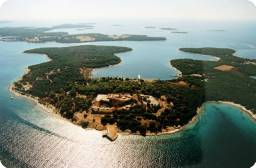

Brioni National Park
Brioni National Park  Wildlife park
Wildlife park
The European hare (Lepus europaeus sp.) already lived on the island, and between 1902 and 1908 the Aksis deer (Aksis aksis), fallow deer (Dama dama) and the mouflon (Ovis musimon) were introduced. Their descendants still adorn the forests, parks and glades of Brijuni and are part of its identity.
Autochthonous birds are quite well represented. Some of the smaller islands are excellent habitats where gulls and sea swallows nest, as well as certain rare genera of cormorant. The Brijuni islands are also important seasonal habitats for northern bird species. The most interesting area is Saline. This is a very damp area with three marshy lakes of 8 acres. The area is fenced off with the aim of forming an ornithological reservation.
The biggest lake is overgrown with reeds and is a good nesting ground for pratincoles, quails, coots, grebes and wild ducks. In the marshes and shallow water, the birds find insects, mosquito larvae and gambusia, small fish that had an important role in the recovery of the island from malaria at the beginning of the last century. In this fenced off area, the underbrush and the low plant cover can grow undisturbed because there is no influence from the larger animals. Therefore, this habitat is ideal for warblers, nightingales, blackbirds, chiffchaffs and other songbirds. In the crowns of pines, we can find nests of sparrow hawks, goshawks and common buzzards. As far as other birds of prey are concerned, there are marsh and moor harriers. By the end of the summer, many different bird species come to Soline on their way south. By August, we can see widgeons, whistling ducks, diving ducks and swallow ducks. The little egret, common heron, yellow-crowned night heron and the rook can also all be seen. The arrival of the great white egrets, the black storks and bitterns indicates that this area is also important for rare and endangered species, which find peace and sufficient quantities of food here.
Source: http://www.brijuni.hr/
Video
Current news
 Macrocruise charter agency
Additional discount on the boat rental price of betw
Macrocruise charter agency
Additional discount on the boat rental price of betw





























